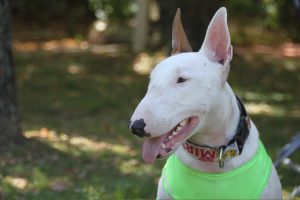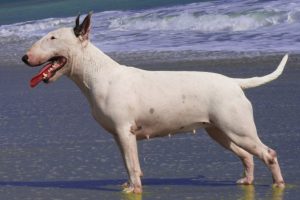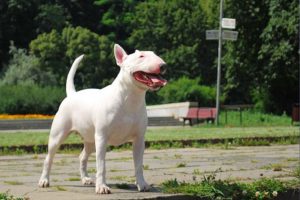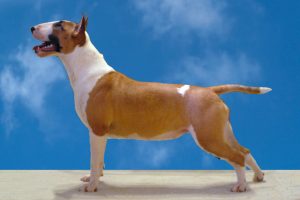
We Tried 5 Fresh Dog Food Brands
Is all the marketing hype worth it? Did our dogs enjoy them? Here’s our dogs’ totally honest review.
English Bull Terrier
The Bull Terrier's physique and temperament are totally unique. He is very aggressive with his fellow creatures, but not at all with humans. Funny and a good player, he will be absolutely calm in the house. He can be very stubborn if he chooses to be. Very attached to his family but at the same time quite independent, this little four-legged paradox is a very special phenomenon of nature. Even if he is not suitable for all types of owners, he remains without doubt a dog to be discovered.
This strange dog is very close to his master. He is therefore highly affectionate and hates solitude. Adorable with everyone, he is very playful and even sometimes very funny.
He loves clowning around for fun. He is very spirited and is rather clumsy with the smaller ones but he is not aggressive at all.
Cats and children are his friends but he doesn't get along that well with his breed. He therefore needs to learn to socialize with his peers.
He has no real aptitude for guarding, but his particular physique is often enough to repel strangers.
Rather balanced and friendly, he is by no means exclusive because he loves everyone.
He is full of energy but he quickly gets tired of prolonged or repetitive exercises, and he greatly appreciates the comfort of a cozy corner by the fire.
Always wanting to be the center of interest of the family, the Bull Terrier also appreciates the comfort of the home and the presence of his family.


It is impossible to confuse the Bull Terrier with any other breed of dog. His ovoid shaped head is unique and is his alone.
His "Roman nose" profile from his ancestor is unique on the whole planet. No other breed can be physically compared to him.
His gladiatorial body is compact and very solid. This ball of muscles leaves a singular and special impression.
Between 35 and 50 cm (13.78 to 19.69 inches) for the male
Between 35 and 50 cm (13.78 to 19.69 inches) for the female
Between 20 and 40 kg (44.09 to 88.18 pounds) for the male
Between 20 and 40 kg (44.09 to 88.18 pounds) for the female
Different colors are allowed for the dress. White, red, brindle and tricolor are among the possibilities but the color must predominate over white for coloured dogs. For the totally white coat, spots are acceptable if they are located on the head.
His hair is short and he has no undercoat.
His egg-shaped head with a "Roman nose" is unique in the world and his skull is almost flat. His narrow eyes are in triangle shape. They are very dark or simply black. His ears are straight on the head. His nose is black. His short tail is carried horizontally.
According to the FCI breeds nomenclature, this breed belongs to group 3, section 3 and is #11
Does this dog suit your lifestyle?
Every dog breed has its own characteristics. However, the actual character of a dog can vary from one to another within the same breed.
Find out if the Bull Terrier is your ideal dog breed with our quiz.
That will take you less than 3 minutes!
Take the quiz





The Bull Terrier is not everyone's dog
Even if he is very cuddly, playful and likes to amuse the gallery, the Bull Terrier remains a stubborn dog, like any good self-respecting Terrier, requiring a nice, firm and determined education.
He never works for his master but for his own pleasure. He does things in his own way and as he sees fit. He must therefore be given a good and specific education with great firmness.
He needs daily stimulation and exercise. A daily walk is the minimum amount of exercise he needs, but a garden where he can play with his family as he pleases will make him happy.
Not at all aggressive, he is not really gifted for guarding but his ancestral genes being still present, it is preferable to avoid stimulating his aggressiveness of the past so that he remains a jovial dog and an excellent companion.
Being naturally stubborn, if his aggressiveness is stimulated, it will be difficult to get rid of it completely.
Very robust and powerful, the Bull Terrier is nevertheless affected by certain hereditary defects as well as certain other health problems such as deafness, skin problems, heart problems and lens dislocation.
Deafness is a hereditary defect resulting from the selection established for his white coat. Even if nowadays fewer Bull puppies are deaf, the problem is far from being totally solved and one must be vigilant when buying a puppy.
The Bull Terrier has a very sensitive skin that is prone to all kinds of ailments. Some are more serious than others.
Especially with white dogs, skin problems are still quite common nowadays. These can be allergies, atopic dermatitis (dry skin), demodecia (parasite) or pyoderma (bacterial infection).
Fortunately, most skin diseases can be treated effectively.
His heart problems come from his ancestor, the English Bulldog. Dysplasia of the mitral valve, heart murmurs and subarticular stenosis are the most common ones.
Depending on the severity of each case, an operation, sometimes costly, may be necessary.
Lens dislocation can be detected by DNA test available since 2009. This hereditary disease gradually leads to blindness in the affected dog.
GROOMING
His very short hair doesn't really need any particular care.
Crossed between the White English Terrier and the English Bulldog in the 13th century, the Bull Terrier comes directly from England.
Originally created for fighting, the breed was almost totally decimated following the abolition of animal fighting by the British Parliament in 1835.
Recognized in 1835 in England but only in 1943 in France, the breed owes a lot to the man nicknamed "The Father of the Breed", Mr. James Hink.
When the latter introduced Dalmatian blood to the breed, the white coat Bull Terrier was then created.
His children, James and Fred, as well as his grandson, Carleton, continued his work and began breeding in 1920.
Having fought bulls, horses and bears, the Bull Terrier was originally endowed with great, well-built muscular strength, which he retained even after the abolition of fighting.
Having completely disappeared after the First World War, he is today much more suitable for company than for fighting.
His pas aggressiveness remains entrenched, but if not awakened in the animal, it remains buried to make room nowadays for a nice and much appreciated life companion.
https://www.flickr.com/photos/7326810@N08/39609442700
https://commons.wikimedia.org/wiki/File:Bull_Terrier4.jpg
https://www.pexels.com/photo/animal-black-blue-bull-terrier-543475/
https://commons.wikimedia.org/wiki/File:Bull_Terrier_R_01.jpg?uselang=fr
https://commons.wikimedia.org/wiki/File:Bullterrier_Bull_Terrier_Mirta_1.jpg
https://pxhere.com/fr/photo/1337917
https://commons.wikimedia.org/wiki/File:Dog_bullterirer.jpg
https://commons.wikimedia.org/wiki/File:Bullterrier_femelle.jpg
https://pixabay.com/es/photos/perro-mascotas-bull-terrier-2720318/

Is all the marketing hype worth it? Did our dogs enjoy them? Here’s our dogs’ totally honest review.